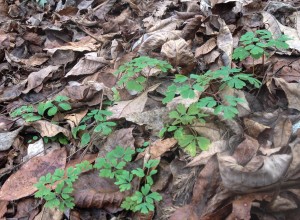
false rue anemone…

cyclamen hederifolium…
January is frigid in many parts of the country and can be a bleak month at best. But it’s also a good time to take a walk through your landscape, observing and planning. Here are some things I spotted on a short walk recently.

geranium ‘Biokovo’…
Native plants like false rue anemone, Enemion biturnatum, are beginning to show through the fallen leaves and promise pure white blooms this spring. Only the bloodroot is a purer white. The cyclamen hederifolium blooms are past, but the pretty mottled foliage is spreading. Here’s some under a native azalea. There are also crocus bulbs interplanted with these cyclamen that will be coming through the leaf litter soon.

selaginella…
Perennial geraniums are good, tough plants too. Here the foliage of Geranium x cantabrigiense ‘Biokovo’, a cranesbill geranium, is looking quite happy along a rocky slope. It’s a pretty groundcover here and gets enough sun in this spot to bloom in the late spring. After the white flowers tinged with pink fade, I’ll clip it back to keep it tidy.

acorus variegata…
A little farther down the slope, and in more shade, is some selaginella uncinata, or peacock spikemoss. This groundcover is closely related to ferns and likes this shaded, moist spot. By midsummer, with enough moisture, it will be a lush, blue/green carpet underneath the trees and sheltered by the rock outcrop.
Below the rock outcrop, and along a dry riverbed, a spring provides water for evergreen acorus. In addition to Acorus ‘Ogon’, a yellow variegated form, here is the Acorus variegata, with a white variegation. Both of these love moisture, and they spread freely. In February these will get cut back at the same time the dwarf mondo is cut, making way for new, fresh growth.

holly ferns…
Other plants that will need old, tattered, winter damaged fronds cut off next month are the perennial ferns, including tassel (polystichum polyblepharum), autumn (Drypteris erythrosora), and, shown here, holly ferns (Cyrtomium falcatum). Sure, they’re evergreen, but, by winter’s end, they definitely need cleaning up. Wait until at least the end of February to do any drastic cutting back, though, as the old foliage also helps protect the crown of the plants from cold temperatures.
 Above the water but spreading down the slope toward it, is a planting of Virginia sweetspire, Itea virginica ‘Henry’s Garnet’ , still holding the garnet colored fall foliage of its name. Underneath this spreading, suckering, shrub is another common evergreen perennial groundcover, the reliable Lenten roses, helleborus orientalis.
Above the water but spreading down the slope toward it, is a planting of Virginia sweetspire, Itea virginica ‘Henry’s Garnet’ , still holding the garnet colored fall foliage of its name. Underneath this spreading, suckering, shrub is another common evergreen perennial groundcover, the reliable Lenten roses, helleborus orientalis.
These two have gradually spread over the years, and the itea will also show off it’s dainty fragrant white blooms along arching stems this spring. It is truly an all season shrub, and the long lasting lenten roses blooming under them are good companions. Soon enough it will be time to clip off old, winter damaged leaves of the lenten roses, but not yet. January is the month to simply observe, taking time to enjoy a quiet walk through the garden on a sunny, chilly day.

